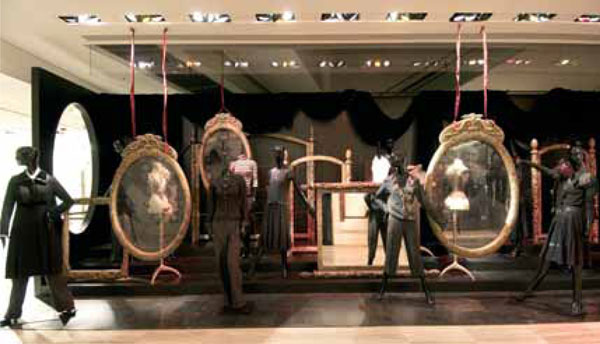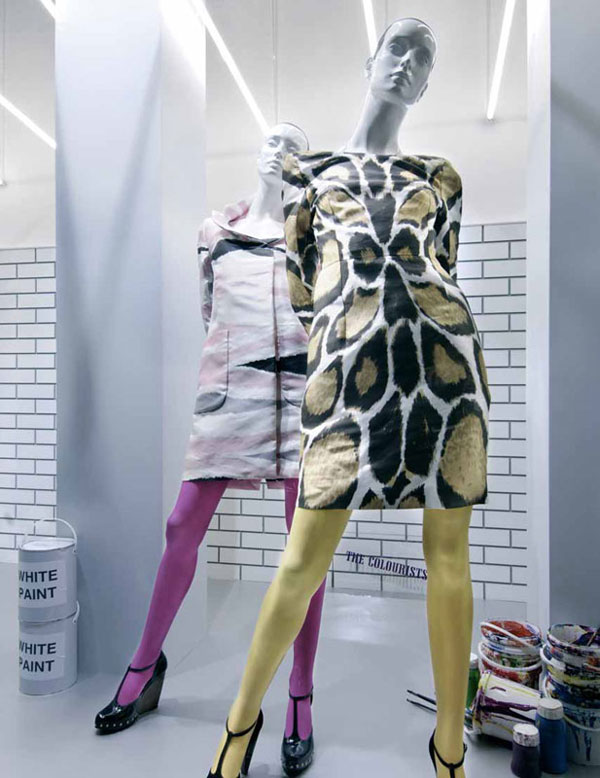Visual merchandising in a department store
Department stores will give a novice excellent training and knowledge of visual merchandising because of the diverse range of products that they house. The training to be gained from an established team is invaluable.
Traditionally, those entering a visual merchandising team in a department store will begin as dresser or junior visual merchandiser; if they work hard and show that they are willing, they may be promoted within two years to a senior role. Managers are likely to spot potential and develop those they see as future managers by encouraging them to develop their communication and managerial skills, to begin managing a budget and to develop a complete window scheme before they are promoted to a managerial role. Those dressers who enjoy the hands-on practicalities of working on displays may prefer not to pursue a managerial role, given all the administration it involves. A regional department store may have its own visual merchandising team, which takes its lead from the flagship store, but the career path there will be similar to that in the flagship store, with the regional manager controlling the budget and recruitment for the regional store.
Mark Briggs of Harrods recruits most of his 67 staff as students. After completing work experience, they go on to assist him dressing 1.25 miles (2 km) of window space and merchandising 1,000,000 sq ft (92,903 square metres) of shop floor. Mark says that a good structure is key to the smooth running of his team. “Communication is the key word,” he explains. “I hold weekly meetings with my team leaders to explain future concepts and promotions to make them feel part of the Harrods family.”
Harrods, like many department stores worldwide, employs separate interior and window visual merchandising teams. A visual merchandiser often has the chance to choose which of the two he or she prefers to excel in; others, however, will be placed according to their merits and talents. Working in both categories will give the trainee visual merchandiser a better overall knowledge and may make the individual more marketable.

Oversized gilt picture frames are used as props in this in-store display to create drama and atmosphere at Lane Crawford, Hong Kong.

Also at Lane Crawford, these immaculately dressed mannequins interact with housewares to make dramatic in-store displays.
A typical department-store visual merchandising structure would be:
Senior visual merchandise manager/director
Responsibilities
To establish and oversee the creative look of the store.
To liaise with the buying director to ensure that the correct product is promoted.
To work closely with the operation director to guarantee that the store layouts are planned correctly.
To communicate with the marketing director to make certain that the visual merchandising team supports any store product promotions.
To control a payroll and visual merchandising budget.
To purchase relevant props and mannequins.
To recruit qualified staff.
To manage the store’s graphics and signage.
Visual merchandise manager
Responsibilities
To manage a team.
To liaise with buyers and marketing.
To communicate with the senior visual merchandise manager.
To design and implement in-store and window displays.
To interact with the graphics team.
To liaise with floor managers.
To know competitors.
To communicate with brands.
Senior visual merchandiser
Responsibilities
To mentor junior members of the team.
To act as a bridge between visual merchandise manager and floor manager.
To be aware of fashion trends and key looks.
To maintain retail standards.
To communicate with the graphics team.
To educate shop-floor staff.
To work closely with brands to ensure a consistent product representation.
Junior/dresser visual merchandiser
Responsibilities
To maintain retail standards.
To be aware of fashion trends.
To work closely with shop-floor staff to ensure visual guidelines are met.
To understand and be aware of brands.
To present merchandise both creatively and with the maximization of sales in mind.
In addition, a visual merchandising team will include an important support team whose members may include the following:
Carpenters
A carpenter’s role within a department store is not just confined to the making of props in the studio; he or she will be instrumental in installing and removing windows and in-store displays. Fully qualified and professionally trained carpenters will also know when a prop needs to be finished to a high standard because it may be placed where the public will scrutinize it up close, and when to compromise on overall quality because it may only be viewed from the front and through glass. Carpenters working in a visual merchandising team will often be able to extend their talents beyond working in wood and will be able to make props from a variety of media.
Painters
Apart from the obvious—painting windows—a painter working in a visual merchandising team may offer a variety of skills. Many are experts in paint effects, and—in conjunction with the carpenters—will be responsible for applying the finishing touches to eye-catching props and window schemes.
Porters
It may seem a luxury to employ porters. However, ensuring that valuable furniture and exquisite props enter and leave the windows in one piece is essential. Most porters will also be responsible for managing and maintaining the stockroom that houses props and mannequins.
Graphic designers
In-house graphics teams are now slowly being disbanded in favor of outside agencies that provide not only the ideas but also the equipment and skill to create a store’s artwork. The benefits of an in-house graphics team are, however, unquestionable. Unlike outside contractors, its members will be aware of the store’s overall image and, undoubtedly, having them on hand to produce samples that can be edited on-site saves a lot of valuable time. In or out of house, a graphics team is responsible for the consistent application of the store’s graphic design to price tags, banners, and promotional information.
Paint tins and brushes as props complement brightly colored hosiery in this “Colorist” window theme, which involved Selfridges’ (London) whole visual merchandising team, from managers to graphic designers.

